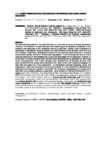Por favor, use este identificador para citar o enlazar este ítem:
http://www.alice.cnptia.embrapa.br/alice/handle/doc/1036656Registro completo de metadatos
| Campo DC | Valor | Lengua/Idioma |
|---|---|---|
| dc.contributor.author | KMIT, M. C. P. | pt_BR |
| dc.contributor.author | LIMA, A. O. S. | pt_BR |
| dc.contributor.author | ROMAGNOLI, E. M. | pt_BR |
| dc.contributor.author | ABDALLA, A. L. | pt_BR |
| dc.contributor.author | MENDES, R. | pt_BR |
| dc.date.accessioned | 2016-02-13T03:21:23Z | - |
| dc.date.available | 2016-02-13T03:21:23Z | - |
| dc.date.created | 2016-02-11 | pt_BR |
| dc.date.issued | 2015 | pt_BR |
| dc.identifier.citation | In: CONGRESSO BRASILEIRO DE MICROBIOLOGIA, 28., Florianópolis. Anais... Florianópolis: Sociedade Brasileira de Microbiologia, 2015. Ref. 1676-1. | pt_BR |
| dc.identifier.uri | http://www.alice.cnptia.embrapa.br/alice/handle/doc/1036656 | pt_BR |
| dc.description | Abstract: The lignocellulose present in the plant biomass, is a promising source of energy generation. However, the breakdown of plant biomass into simple sugars for bioethanol production is still inefficient and costly due to the recalcitrant nature of plant fiber. Sheep rumen microbiome is specialized in degradation of plant material, but most members of this complex community are non-cultivable in laboratory. Therefore, the search for new lignocellulolytic enzymes in microbial communities naturally evolved in the biomass degradation, in environments such as the rumen, using the exploration of the metagenome, is a promising strategy for the exploration of genes. In this context, this study aimed to obtain plant biomass-degrading genes, selected from the sheep rumen microorganisms. The rumen samples were collected from 6 fistulated animals (Ovis aries), divided into two groups and subjected to two diets: control and sugarcane bagasse, 60 days after the beginning of the experiment. To characterize biomass-degrading genes, the metagenomic DNA was extracted from the solid contents of rumen followed by sequencing in MiSeq Personal Sequencer platform (Illumina®). We analyzed, 4,68 gigabases of metagenomic total DNA from microbes adherent to plant fiber, using on the CLC Genomic Workbench v.5.5.1 platform (CLC Bio, Denmark). The assembled contigs that allowed identification of 27 putative partial carbohydrate-active enzymes (CAE) (NCBI-nr) representing a total of 11 lignocellulases, 13 amylases and 3 other putative CAE from animals fed with control diet and 106 putative partial CAE representing a total of 52 lignocellulases, 46 amylases and 8 other putative CAE from animals fed with diet amended with sugarcane bagasse. These data sets shows the sheep rumen microbiome as an untapped source of potential new fibrolytic enzymes. Using a diet amended with sugarcane bagasse increases the abundance of CAE and provide a substantially expanded catalog of genes participating in the deconstruction of plant biomass | pt_BR |
| dc.language.iso | eng | eng |
| dc.rights | openAccess | eng |
| dc.subject | Lignocelluloytic enzymes | pt_BR |
| dc.subject | Secind generation biofuel | pt_BR |
| dc.subject | Microbial metagenome | pt_BR |
| dc.title | Sheep rumen shotgun sequencing for biomass-degrading genes discovery. | pt_BR |
| dc.type | Resumo em anais e proceedings | pt_BR |
| dc.date.updated | 2016-02-13T03:21:23Z | pt_BR |
| dc.subject.thesagro | Enzima | pt_BR |
| dc.subject.thesagro | Biotecnologia | pt_BR |
| dc.subject.nalthesaurus | Metagenomics | pt_BR |
| riaa.ainfo.id | 1036656 | pt_BR |
| riaa.ainfo.lastupdate | 2016-02-12 | pt_BR |
| dc.contributor.institution | M. C. P. KMIT, ESALQ/USP; A. O. S. LIMA, UNIVALI; E. M. ROMAGNOLI, ESALQ/USP; A. L. ABDALLA, CENA; RODRIGO MENDES, CNPMA. | pt_BR |
| Aparece en las colecciones: | Resumo em anais de congresso (CNPMA)  | |
Ficheros en este ítem:
| Fichero | Descripción | Tamaño | Formato | |
|---|---|---|---|---|
| 2015RA065.pdf | 104,51 kB | Adobe PDF |  Visualizar/Abrir |









